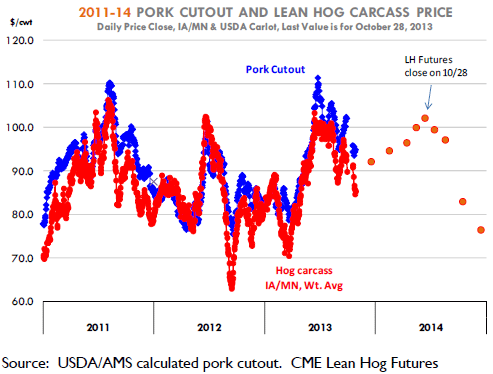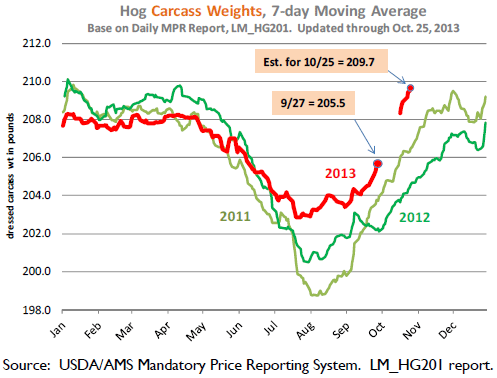



CME: Hog Weights Continue to Climb
US - Hog futures have been buoyed in recent days by ongoing speculation that hog/pork prices will remain firm on good demand prospects and short supplies due to the spread of PEDv virus, write Steve Meyer and Len Steiner.On the demand front, the expectation of tight cattle supplies and record beef prices certainly has been supportive of the hog and pork market. Consumer disposable incomes going into the holidays are modestly better, in part thanks to lower energy costs.
There is plenty of attention on the unemployment rate but given the number of people that have left the labor force and have yet to come back, that may not be as reliable an indicator as it appears. As for export demand, there is plenty of hope for the future even as the actual data continues to show pork exports tracking below year ago levels.
There continues to be a lot of speculation that China will become a more active buyer in the US market. At this point Chinese purchases of US pork are slowly moving up but the market continues to price significant gains in the coming year.
As we noted yesterday, market participants continue to focus on the potential impact that PEDv virus is having on US pork production in 2014. It is difficult to peg much of the shortfall in hog supplies in September and so far in October on PEDv.
While it is possible that the disease was active earlier than reports indicate, we have no knowledge of that being the case. More likely it appears that high feed costs caused producers to reduce the number of pigs that were born during Mar - May period.
Based on current slaughter numbers, it looks like a fair bet that USDA will have to go back and revise the pig crop numbers significantly for that time period. Now the focus is on the potential impact of the virus. There are plenty of guesses out there and there is simply too much confusion to really come up with any firm numbers.
The situation in North Carolina and the expansion of the disease there certainly is a cause for concern. Some wire stories quote that over 150,000 sows may have been affected. With a little over ten pigs per litter, we could see an impact of about 1.5 million pigs spread out over a number of weeks. Then there is the issue of new cases in Iowa.
The numbers there are vague as well. More importantly, however, the market remains particularly concerned as to what the current spread implies for the industry this winter. Normally there are more hogs being moved around in Q4 as total numbers are larger. This tends to contribute to the spread of the disease. For now, futures have built a significant risk premium in the hog contracts for Q2 and Q3. For those hog producers that are able to take advantage, this presents a good opportunity to lock in some of the best profits.
One final note that may offer some restraint to all the bullish talk. Hog weights continue to climb and they are now hovering near 210 pounds/carcass. Given normal trends, hog weights could climb further in November. This will offset some of the decline in slaughter and could limit the upside currently futures are pricing in the very short term.










